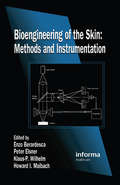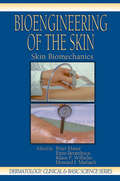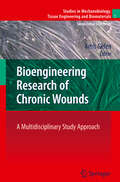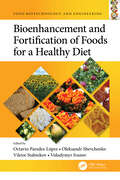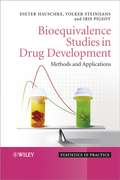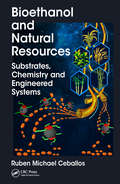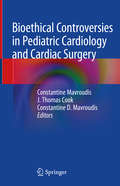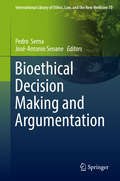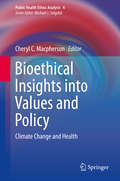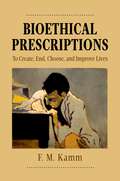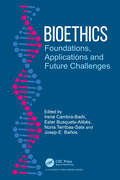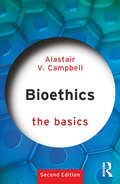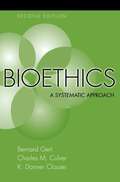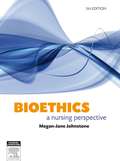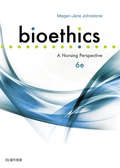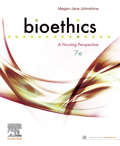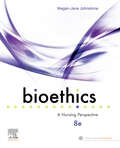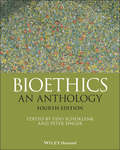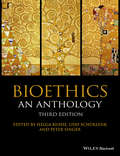- Table View
- List View
Bioengineering of the Skin: Methods and Instrumentation, Volume III
by Enzo Berardesca Peter Elsner Klaus-Peter Wilhelm Howard I. MaibachSkin bioengineering is an expanding field of investigative and clinical dermatology. This guide describes all commercially available techniques and instruments. It provides a thorough overview of methods for noninvasive investigation of skin function. Commercially available instruments are reviewed and compared, with updated references given for each instrument. This book offers a technical analysis of each instrument, allowing investigators to understand its biophysical principles and to make better purchases of lab instruments. Addresses of manufacturers and worldwide distributors are included, making this an essential reference source.Chapters are written by international experts. Topics include transepidermal water loss, hydration, the measurement of skin blood flow in Laser-Doppler flowetry, sebum, pH and ions, and transcutaneous pO2 and pO2 measurements. Skin color, roughness, and elasticity are examined in detail. Skin imaging techniques, capillaroscopy, and fluorescence videomicroscopy are described. Instruments for surface microscopy of the skin are also discussed.Bioengineering of the Skin explains state-of-the-art techniques and is valuable reading for anyone who needs to stay abreast of the latest activities in this ever-changing field.
Bioengineering of the Skin: Skin Biomechanics, Volume V
by Peter Elsner Enzo Berardesca Klaus-Peter WilhelmSince skin forms the interface between the human body and the environment, its mechanical properties are important in health and disease. Bioengineering of the Skin: Skin Biomechanics gives a thorough introduction in the biological basis of skin biomechanics. It explains the non-invasive methods that allow measurement of the mechanical properties o
Bioengineering Research of Chronic Wounds: A Multidisciplinary Study Approach (Studies in Mechanobiology, Tissue Engineering and Biomaterials #1)
by Amit GefenPressure-related chronic wounds are an important health concern that affects millions of patients and accumulates billions in annual costs. These wounds may occur when soft tissues are mechanically compressed between bony prominences and a supporting surface. This book gives a complete and quantitative explanation of the mechanobiology which causes chronic wounds. The reviews give an overall picture on all length scales of the phenomenon, starting from musculoskeletal biomechanics to the modeling of soft tissues and their interaction with bones. At the microscopic levels, it thoroughly reviews experiments and modeling of cellular forces and molecular processes that occur during injury and healing, including the integrity of living cells subjected to sustained mechanical forces and deformations. The results allow a complete picture of the tolerance of human tissues to sustained loads, and an understanding of the risk for onset of chronic wounds. Hence, this book is also valuable for all professionals involved in the prevention and treatment of chronic wounds.
Bioenhancement and Fortification of Foods for a Healthy Diet (Food Biotechnology and Engineering)
by Octavio Paredes-López Oleksandr Shevchenko Viktor Stabnikov Volodymyr IvanovBioenhancements of cereal and dairy compositions can play an important role in healthy diets. The latest addition to the new Food Biotechnology and Engineering series, Bioenhancement and Fortification of Foods for a Healthy Diet covers the technological and nutritional aspects of the compositions of cereals, dairy products, vegetables, and fruits. The book demonstrates real developments in food technology and reviews current knowledge in the biotechnological processing and bioenhancement of food. Key Features: Promotes the use of iron-containing nanoadditive in bakery and confectionary Explains the use of food additives for enrichment of butter mixtures Covers the use of artichoke powder and buckwheat bran in diabetic bakery products Describes the use of milk proteins in the technology of bakery products Proposes the use of spice compositions for sour milk products Organized in five parts, Bioenhancement and Fortification of Foods for a Healthy Diet addresses bakery and confectionery products, technologies for cereals enhancement, technologies for dairy products enhancement, food supplements, and finally, new technology processes. The book is an aide to food scientists and engineers contributing to the development of high-quality food products. Also available in the Food Biotechnology and Engineering series: Volatile Compounds Formation in Specialty Beverages, edited by Felipe Richter Reis and Caroline Mongruel Eleutério dos Santos (ISBN: 9780367631901) Native Crops in Latin America: Biochemical, Processing, and Nutraceutical Aspects, edited by Ritva Repo-Carrasco-Valencia and Mabel C. Tomás (ISBN: 9780367531409) For a complete list of books in this series, please visit our website at: https://www.routledge.com/Food-Biotechnology-and-Engineering/book-series/CRCFOOBIOENG
Bioenhancement and Fortification of Foods for a Healthy Diet (Food Biotechnology and Engineering)
by Octavio Paredes-López Oleksandr Shevchenko Viktor Stabnikov Volodymyr IvanovBioenhancements of cereal and dairy compositions can play an important role in healthy diets. The latest addition to the new Food Biotechnology and Engineering series, Bioenhancement and Fortification of Foods for a Healthy Diet covers the technological and nutritional aspects of the compositions of cereals, dairy products, vegetables, and fruits. The book demonstrates real developments in food technology and reviews current knowledge in the biotechnological processing and bioenhancement of food. Key Features: Promotes the use of iron-containing nanoadditive in bakery and confectionary Explains the use of food additives for enrichment of butter mixtures Covers the use of artichoke powder and buckwheat bran in diabetic bakery products Describes the use of milk proteins in the technology of bakery products Proposes the use of spice compositions for sour milk products Organized in five parts, Bioenhancement and Fortification of Foods for a Healthy Diet addresses bakery and confectionery products, technologies for cereals enhancement, technologies for dairy products enhancement, food supplements, and finally, new technology processes. The book is an aide to food scientists and engineers contributing to the development of high-quality food products. Also available in the Food Biotechnology and Engineering series: Volatile Compounds Formation in Specialty Beverages, edited by Felipe Richter Reis and Caroline Mongruel Eleutério dos Santos (ISBN: 9780367631901) Native Crops in Latin America: Biochemical, Processing, and Nutraceutical Aspects, edited by Ritva Repo-Carrasco-Valencia and Mabel C. Tomás (ISBN: 9780367531409) For a complete list of books in this series, please visit our website at: https://www.routledge.com/Food-Biotechnology-and-Engineering/book-series/CRCFOOBIOENG
Bioequivalence and Statistics in Clinical Pharmacology (Chapman & Hall/CRC Biostatistics Series)
by Scott D. Patterson Byron JonesMaintaining a practical perspective, Bioequivalence and Statistics in Clinical Pharmacology, Second Edition explores statistics used in day-to-day clinical pharmacology work. The book is a starting point for those involved in such research and covers the methods needed to design, analyze, and interpret bioequivalence trials; explores when, how, and why these studies are performed as part of drug development; and demonstrates the methods using real world examples. Drawing on knowledge gained directly from working in the pharmaceutical industry, the authors set the stage by describing the general role of statistics. Once the foundation of clinical pharmacology drug development, regulatory applications, and the design and analysis of bioequivalence trials are established, including recent regulatory changes in design and analysis and in particular sample-size adaptation, they move on to related topics in clinical pharmacology involving the use of cross-over designs. These include, but are not limited to, safety studies in Phase I, dose-response trials, drug interaction trials, food-effect and combination trials, QTc and other pharmacodynamic equivalence trials, proof-of-concept trials, dose-proportionality trials, and vaccines trials. This second edition addresses several recent developments in the field, including new chapters on adaptive bioequivalence studies, scaled average bioequivalence testing, and vaccine trials. Purposefully designed to be instantly applicable, Bioequivalence and Statistics in Clinical Pharmacology, Second Edition provides examples of SAS and R code so that the analyses described can be immediately implemented. The authors have made extensive use of the proc mixed procedures available in SAS.
Bioequivalence and Statistics in Clinical Pharmacology (Chapman & Hall/CRC Biostatistics Series)
by Scott D. Patterson Byron JonesMaintaining a practical perspective, Bioequivalence and Statistics in Clinical Pharmacology, Second Edition explores statistics used in day-to-day clinical pharmacology work. The book is a starting point for those involved in such research and covers the methods needed to design, analyze, and interpret bioequivalence trials; explores when, how, and why these studies are performed as part of drug development; and demonstrates the methods using real world examples. Drawing on knowledge gained directly from working in the pharmaceutical industry, the authors set the stage by describing the general role of statistics. Once the foundation of clinical pharmacology drug development, regulatory applications, and the design and analysis of bioequivalence trials are established, including recent regulatory changes in design and analysis and in particular sample-size adaptation, they move on to related topics in clinical pharmacology involving the use of cross-over designs. These include, but are not limited to, safety studies in Phase I, dose-response trials, drug interaction trials, food-effect and combination trials, QTc and other pharmacodynamic equivalence trials, proof-of-concept trials, dose-proportionality trials, and vaccines trials. This second edition addresses several recent developments in the field, including new chapters on adaptive bioequivalence studies, scaled average bioequivalence testing, and vaccine trials. Purposefully designed to be instantly applicable, Bioequivalence and Statistics in Clinical Pharmacology, Second Edition provides examples of SAS and R code so that the analyses described can be immediately implemented. The authors have made extensive use of the proc mixed procedures available in SAS.
Bioequivalence Requirements in Various Global Jurisdictions (AAPS Advances in the Pharmaceutical Sciences Series #28)
by Isadore KanferAlthough the Bioequivalence (BE) requirements in many global jurisdictions have much in common, differences in certain approaches and requirements such as definitions and terms, choice of comparator (reference) product, acceptance criteria, fasted and fed studies, single and multi-dose studies, biowaivers and products not intended for absorption into the systemic circulation (locally acting medicines and dosage forms), amongst others, provide food for thought that standardisation should be a high priority objective in order to result in a harmonized international process for the market approval of products using BE. An important objective of Bioequivalence Requirements in Various Global Jurisdictions is to attempt to gather the various BE requirements used in different global jurisdictions to provide a single source of relevant information. This information from, Brazil, Canada, China, European Union, India, Japan, MENA, Russia South Africa, the USA and WHO will be of value to drug manufacturers, regulatory agencies, pharmaceutical scientists and related health organizations and governments around the world in the quest to harmonize regulatory requirements for the market approval of generic products.
Bioequivalence Studies in Drug Development: Methods and Applications (Statistics in Practice #60)
by Dieter Hauschke Volker Steinijans Iris PigeotStudies in bioequivalence are the commonly accepted method to demonstrate therapeutic equivalence between two medicinal products. Savings in time and cost are substantial when using bioequivalence as an established surrogate marker of therapeutic equivalence. For this reason the design, performance and evaluation of bioequivalence studies have received major attention from academia, the pharmaceutical industry and health authorities. Bioequivalence Studies in Drug Development focuses on the planning, conducting, analysing and reporting of bioequivalence studies, covering all aspects required by regulatory authorities. This text presents the required statistical methods, and with an outstanding practical emphasis, demonstrates their applications through numerous examples using real data from drug development. Includes all the necessary pharmacokinetic background information. Presents parametric and nonparametric statistical techniques. Describes adequate methods for power and sample size determination. Includes appropriate presentation of results from bioequivalence studies. Provides a practical overview of the design and analysis of bioequivalence studies. Presents the recent developments in methodology, including population and individual bioequivalence. Reviews the regulatory guidelines for such studies, and the existing global discrepancies. Discusses the designs and analyses of drug-drug and food-drug interaction studies. Bioequivalence Studies in Drug Development is written in an accessible style that makes it ideal for pharmaceutical scientists, clinical pharmacologists, and medical practitioners, as well as biometricians working in the pharmaceutical industry. It will also be of great value for professionals from regulatory bodies assessing bioequivalence studies.
Bioethanol and Natural Resources: Substrates, Chemistry and Engineered Systems
by Ruben Michael CeballosBioethanol and Natural Resources: Substrates, Chemistry and Engineered Systems provides a comprehensive review of feedstocks, physiochemical and biological pretreatments, molecular substrates, cellulolytic and ligninolytic enzymes, and advanced technologies for producing bioethanol. Although this book provides a review of first-generation bioethanol feedstocks, chemistry, and processes, there is an emphasis on second-generation "cellulosic" ethanol production. With rapid advances in biofuels technologies and the continued global dependency on unsustainable extraction of fossil fuels, this text is timely. Although it is intended to be used as a supplemental text for advanced undergraduate or graduate level courses, the book is accessible to a non-academic audience. This book provides a unique opportunity to understand bioethanol production from the basic concepts and processes to the most cutting-edge technologies under development.
Bioethanol and Natural Resources: Substrates, Chemistry and Engineered Systems
by Ruben Michael CeballosBioethanol and Natural Resources: Substrates, Chemistry and Engineered Systems provides a comprehensive review of feedstocks, physiochemical and biological pretreatments, molecular substrates, cellulolytic and ligninolytic enzymes, and advanced technologies for producing bioethanol. Although this book provides a review of first-generation bioethanol feedstocks, chemistry, and processes, there is an emphasis on second-generation "cellulosic" ethanol production. With rapid advances in biofuels technologies and the continued global dependency on unsustainable extraction of fossil fuels, this text is timely. Although it is intended to be used as a supplemental text for advanced undergraduate or graduate level courses, the book is accessible to a non-academic audience. This book provides a unique opportunity to understand bioethanol production from the basic concepts and processes to the most cutting-edge technologies under development.
Bioethical Controversies in Pediatric Cardiology and Cardiac Surgery
by Constantine Mavroudis J. Thomas Cook Constantine D. MavroudisThis title reviews the bioethical issues in congenital heart disease and other difficult pediatric cardiology and cardiac surgical situations. It provides considered opinions and recommendations as to the preferred actions to take in these cases, stressing the importance of making informed decisions that are bioethically sound and doing so using considered reasoning of all the related sensitive issues.Bioethical Controversies in Pediatric Cardiology and Cardiac Surgery provides detailed recommendations on potential solutions to make bioethical decisions in difficult clinical scenarios. There is particular emphasis on controversies involving surgery for hypoplastic left heart syndrome, futility, informed consent, autonomy, genomics, and beneficence. It is intended for use by a wide range of practitioners, including congenital heart surgeons, pediatric cardiologists, pediatric intensivists, nurse practitioners, physician’s assistants, and clinical ethicists.
Bioethical Decision Making and Argumentation (International Library of Ethics, Law, and the New Medicine #70)
by Pedro Serna José-Antonio SeoaneThis book clarifies the meaning of the most important and pervasive concepts and tools in bioethical argumentation (principles, values, dignity, rights, duties, deliberation, prudence) and assesses the methodological suitability of the main methods for clinical decision-making and argumentation. The first part of the book is devoted to the most developed or promising approaches regarding bioethical argumentation, namely those based on principles, values and human rights. The authors then continue to deal with the contributions and shortcomings of these approaches and suggest further developments by means of substantive and procedural elements and concepts from practical philosophy, normative systems theory, theory of action, human rights and legal argumentation. Furthermore, new models of biomedical and health care decision-making, which overcome the aforementioned criticism and stress the relevance of the argumentative responsibility, are included.
Bioethical Insights into Values and Policy: Climate Change and Health (Public Health Ethics Analysis #4)
by Cheryl C. MacphersonChanges in earth’s atmosphere, oceans, soil, weather patterns, and ecosystems are well documented by countless scientific disciplines. These manifestations of climate change harm public health. Given their goals and social responsibilities, influential health organizations recognize health impacts compounded by geography, social values, social determinants of health, health behaviors, and relationships between humans and environments primarily described in feminist ethics and environmental ethics. Health impacts are relevant to, but seldom addressed in bioethics, global health, public policy, or health or environmental policy. This book is the first to describe cultural, geographic, and socioeconomic factors that influence the regional significance of these impacts and frame them for bioethics and policy analyses.
Bioethical Prescriptions: To Create, End, Choose, and Improve Lives (Oxford Ethics Series)
by F.M. KammBioethical Prescriptions collects F.M. Kamm's articles on bioethics, which have appeared over the last twenty-five years and which have made her among the most influential philosophers in this area. Kamm is known for her intricate, sophisticated, and painstaking philosophical analyses of moral problems generally and of bioethical issues in particular. This volume showcases these articles -- revised to eliminate redundancies -- as parts of a coherent whole. A substantive introduction identifies important themes than run through the articles. Section headings include Death and Dying; Early Life (on conception and use of embryos, abortion, and childhood); Genetics and Other Enhancements (on cloning and other genetic technologies); Allocating Scarce Resources; and Methodology (on the relation of moral theory and practical ethics).
Bioethics: Foundations, Applications and Future Challenges
by Irene Cambra-Badii Ester Busquets-Alibés Terribas-Sala Núria Josep-E. BañosThe aim of this book is to introduce and discuss bioethics in a three-synergistic way: from the foundations to the current debates in relation to healthcare and social bioethics, and thereafter the possible future challenges. In this sense, the target audience can be from diverse disciplines: life and medical sciences, law, philosophy, psychology, and education. The book will be useful to high school students, in their first contacts with bioethics, college students, teachers and researchers, and the general public interested in these controversial debates of the past, present and future of bioethics.
Bioethics: The Basics (The Basics)
by Alastair V. CampbellBioethics: The Basics is an introduction to the foundational principles, theories and issues in the study of medical and biological ethics. Readers are introduced to bioethics from the ground up before being invited to consider some of the most controversial but important questions facing us today. Topics addressed include: the range of moral theories underpinning bioethics arguments for the rights and wrongs of abortion, euthanasia and animal research health care ethics including the nature of the practitioner-patient relationship public policy ethics and the implications of global and public health ‘3 parents’, enhancement, incidental findings and nudge approaches in health care. This thoroughly revised second edition provides a concise, readable and authoritative introduction for anyone interested in the study of bioethics.
Bioethics: A Return to Fundamentals
by Bernard Gert Charles M. Culver K. Danner ClouserAn updated and expanded successor to Culver and Gert's Philosophy in Medicine, this book integrates moral philosophy with clinical medicine to present a comprehensive summary of the theory, concepts, and lines of reasoning underlying the field of bioethics. Rather than concentrating narrowly on bioethics and investigating moral philosophy only marginally, the authors provide an explicit account of common morality and show how it applies to and is modified by the realities of clinical medicine. Such broader knowledge finds its specific practical application when one attempts to resolve the more complex and difficult cases. This book does not attempt to settle all controversial matters, but rather provides an ethical framework that various parties to the dispute can accept and use as a basis for reaching agreement. Thus, the authors' main goal is to facilitate ethical discussion. Their detailed analyses of death and disease maintain the theoretical objectivity of these concepts while recognizing their central role in social and medical practices. They also provide in-depth discussions of the central concepts and issues in bioethics: competence, consent, justification for moral rule violations, and confidentiality. Paternalism, one of the most pervasive problems in clinical medicine, is accorded special attention. All these concepts have been integrated and systematically grounded within common morality. The book is richly illustrated with discussions of clinical cases. The authors explicitly compare their position with other accounts of bioethics such as principlism, casuistry, and virtue theory. Their discussion of euthanasia and physician-assisted suicide clarifies and evaluates the recent legal decisions on these topics. The arguments throughout the volume stand out with characteristic clarity and cogency. A fresh and all-encompassing approach to bioethics that does not shy away from controversy, Bioethics: A Return to Fundamentals will interest not only students in philosophy of medicine and medical ethics courses, but also moral philosophers and bioethicists, as well as doctors, nurses, and other health care professionals.
Bioethics: A Nursing Perspective
by Megan-Jane JohnstoneThe 5th edition of Bioethics provides nursing students with the necessary knowledge and understanding of the ethical issues effecting nursing practice. Groundbreaking in its first edition, Bioethics continues its role as a vital component of nursing education and provides a framework for students to understand the obligations, responsibilities and ethical challenges they will be presented with throughout their careers. This latest edition responds to new and emerging developments in the field and marks a significant turning point in nursing ethics in that it serves not only to inform but also to revitalise and progress debate on the issues presented.
Bioethics: A Nursing Perspective
by Megan-Jane JohnstoneAn essential resource for both undergraduate and postgraduate students and registered nurses to develop new insights and moral wisdom around ethical issues they will face in clinical practice. Bioethics: A Nursing Perspective, 6th Edition continues to set the standard for bioethical issues in nursing practice. As with previous editions, this highly respected text provides a comprehensive framework to assist students and registered nurses to understand the ethical challenges, obligations and responsibilities they will encounter in daily practice.Greater depth on ethical issues, particularly those concerned with ethical conduct, unprofessional conduct and professional misconduct and ‘morality politics’ Case scenarios and critical questions to encourage students and registered nurses to reflect on key issues that relate to their own practiceNEW chapters: - Ethics, dehumanisation and vulnerable populations - Professional obligations to report harmful behaviours with a focus on impaired practitioners, child abuse and elder abuseIntroduces a new concept: ‘cultural humility’ Content on ‘needs versus wants’, ‘the right not to be informed’, palliative sedation, preventing ethical conflicts, the relationship between professional judgment and moral decision-making in nursing and health care contexts, and future ethical difficulties concerned with climate change, peak oil, pandemic influenza, antimicrobial resistance and health inequalitiesAll chapters and references have been updated to reflect contemporary nursing practice, locally and globally
Bioethics: A Nursing Perspective
by Megan-Jane JohnstoneWritten by Australia’s foremost nursing ethics scholar, Bioethics: A Nursing Perspective comprehensibly addresses the ethical challenges, obligations and responsibilities nurses will encounter in practice. With a strong emphasis on the principles and standards of human rights and social justice, the 7th edition examines the spectrum of bioethical issues in health care with a focus on patients’ rights, cross-cultural ethics, vulnerability ethics, mental health ethics, professional conduct, patient safety and end-of-life ethics.Coverage of the moral terrain of everyday practice, including: Codes of Ethics and Codes of ConductEnd-of-life care, directives and legislationMoral disengagementPrejudice, discrimination and vulnerable populationsElder abuse and child abuseFuture nursing ethics challenges Case scenarios and critical questions to encourage reflection on key issues in practice Additional resources on Evolve eBook on VitalSource
Bioethics: A Nursing Perspective
by Megan-Jane JohnstoneNow in its eighth edition, Bioethics: A Nursing Perspective provides practical guidance on the ethical issues you might come across in nursing practice, with real-world examples that help to bring this important subject to life. Author Dr Megan-Jane Johnstone AO, Australia's foremost nursing ethics scholar, provides a comprehensive framework for negotiating the ethical challenges, obligations and responsibilities you might face. The text is engaging and easy to follow, and has been fully updated to reflect current issues in health care such as nurse practitioner assisted dying, pandemic ethics, and the moral costs of misinformation and medical conspiracy theories. . This book is a suitable companion to the law and ethics components of both undergraduate and postgraduate nursing studies, and is relevant for all nurses who encounter ethical problems in their everyday practice. Written in an engaging style – suitable for undergraduate as well as postgraduate students and researchers Focuses on prominent and topical ethical issues facing individual nurses as well as the broader profession Covers a broad range of bioethical issues in health care and how these relate to various fundamental traditions in philosophical ethics Real-life case studies and hypothetical scenarios to encourage debate Covers hot topics in modern nursing practice, including: Professional standards How to make moral decisions Cross-cultural ethics, including the problem of racism Dehumanisation and vulnerable populations Patient rights Mental health care ethics End-of-life care Moral politics of abortion and euthanasia Moral lessons of COVID-19 Additional resources on Evolve eBook on VitalSource Questions fostering critical reflection to support learning Key points and new chapter groupings for easy navigation New chapter on pandemic ethics
Bioethics: An Anthology (Blackwell Philosophy Anthologies #27)
by Udo Sch Klenk Peter SingerThe new edition of the classic collection of key readings in bioethics, fully updated to reflect the latest developments and main issues in the field For more than two decades, Bioethics: An Anthology has been widely regarded as the definitive single-volume compendium of seminal readings on both traditional and cutting-edge ethical issues in biology and medicine. Acclaimed for its scope and depth of coverage, this landmark work brings together compelling writings by internationally-renowned bioethicist to help readers develop a thorough understanding of the central ideas, critical issues, and current debate in the field. Now fully revised and updated, the fourth edition contains a wealth of new content on ethical questions and controversies related to the COVID-19 pandemic, advances in CRISPR gene editing technology, physician-assisted death, public health and vaccinations, transgender children, medical aid in dying, the morality of ending the lives of newborns, and much more. Throughout the new edition, carefully selected essays explore a wide range of topics and offer diverse perspectives that underscore the interdisciplinary nature of bioethical study. Edited by two of the field’s most respected scholars, Bioethics: An Anthology: Covers an unparalleled range of thematically-organized topics in a single volume Discusses recent high-profile cases, debates, and ethical issues Features three brand-new sections: Conscientious Objection, Academic Freedom and Research, and Disability Contains new essays on topics such as brain death, life and death decisions for the critically ill, experiments on humans and animals, neuroethics, and the use of drugs to ease the pain of unrequited love Includes a detailed index that allows the reader to easily find terms and topics of interest Bioethics: An Anthology, Fourth Edition remains a must-have resource for all students, lecturers, and researchers studying the ethical implications of the health-related life sciences, and an invaluable reference for doctors, nurses, and other professionals working in health care and the biomedical sciences.
Bioethics: An Anthology (Blackwell Philosophy Anthologies #Vol. 25)
by Helga Kuhse Udo Schüklenk Peter SingerNow fully revised and updated, Bioethics: An Anthology, 3rd edition, contains a wealth of new material reflecting the latest developments. This definitive text brings together writings on an unparalleled range of key ethical issues, compellingly presented by internationally renowned scholars. The latest edition of this definitive one-volume collection, now updated to reflect the latest developments in the field Includes several new additions, including important historical readings and new contemporary material published since the release of the last edition in 2006 Thematically organized around an unparalleled range of issues, including discussion of the moral status of embryos and fetuses, new genetics, neuroethics, life and death, resource allocation, organ donations, public health, AIDS, human and animal experimentation, genetic screening, and issues facing nurses Subjects are clearly and captivatingly discussed by globally distinguished bioethicists A detailed index allows the reader to find terms and topics not listed in the titles of the essays themselves
Bioethics: An Anthology (Blackwell Philosophy Anthologies)
by Helga Kuhse Udo Schüklenk Peter SingerNow fully revised and updated, Bioethics: An Anthology, 3rd edition, contains a wealth of new material reflecting the latest developments. This definitive text brings together writings on an unparalleled range of key ethical issues, compellingly presented by internationally renowned scholars. The latest edition of this definitive one-volume collection, now updated to reflect the latest developments in the field Includes several new additions, including important historical readings and new contemporary material published since the release of the last edition in 2006 Thematically organized around an unparalleled range of issues, including discussion of the moral status of embryos and fetuses, new genetics, neuroethics, life and death, resource allocation, organ donations, public health, AIDS, human and animal experimentation, genetic screening, and issues facing nurses Subjects are clearly and captivatingly discussed by globally distinguished bioethicists A detailed index allows the reader to find terms and topics not listed in the titles of the essays themselves
